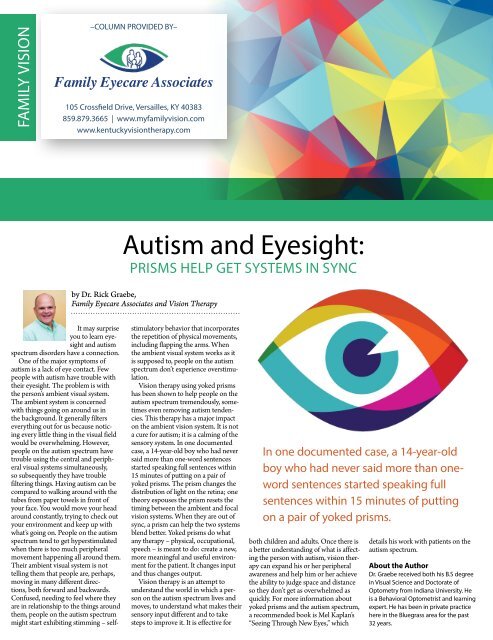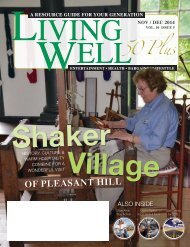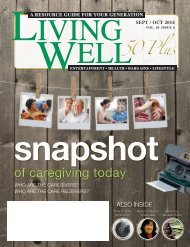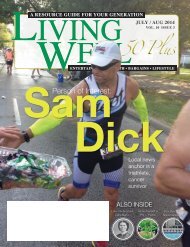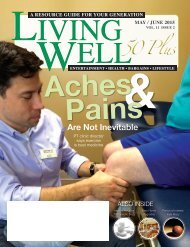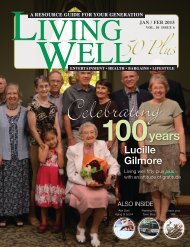You also want an ePaper? Increase the reach of your titles
YUMPU automatically turns print PDFs into web optimized ePapers that Google loves.
FAMILY VISION<br />
–COLUMN PROVIDED BY–<br />
Family Eyecare Associates<br />
105 Crossfield Drive, Versailles, KY 40383<br />
859.879.3665 | www.myfamilyvision.com<br />
www.kentuckyvisiontherapy.com<br />
Autism and Eyesight:<br />
PRISMS HELP GET SYSTEMS IN SYNC<br />
by Dr. Rick Graebe,<br />
Family Eyecare Associates and Vision Therapy<br />
It may surprise<br />
you to learn eyesight<br />
and autism<br />
spectrum disorders have a connection.<br />
One of the major symptoms of<br />
autism is a lack of eye contact. Few<br />
people with autism have trouble with<br />
their eyesight. The problem is with<br />
the person’s ambient visual system.<br />
The ambient system is concerned<br />
with things going on around us in<br />
the background. It generally filters<br />
everything out for us because noticing<br />
every little thing in the visual field<br />
would be overwhelming. However,<br />
people on the autism spectrum have<br />
trouble using the central and peripheral<br />
visual systems simultaneously,<br />
so subsequently they have trouble<br />
filtering things. Having autism can be<br />
compared to walking around with the<br />
tubes from paper towels in front of<br />
your face. You would move your head<br />
around constantly, trying to check out<br />
your environment and keep up with<br />
what’s going on. People on the autism<br />
spectrum tend to get hyperstimulated<br />
when there is too much peripheral<br />
movement happening all around them.<br />
Their ambient visual system is not<br />
telling them that people are, perhaps,<br />
moving in many different directions,<br />
both forward and backwards.<br />
Confused, needing to feel where they<br />
are in relationship to the things around<br />
them, people on the autism spectrum<br />
might start exhibiting stimming – selfstimulatory<br />
behavior that incorporates<br />
the repetition of physical movements,<br />
including flapping the arms. When<br />
the ambient visual system works as it<br />
is supposed to, people on the autism<br />
spectrum don’t experience overstimulation.<br />
Vision therapy using yoked prisms<br />
has been shown to help people on the<br />
autism spectrum tremendously, sometimes<br />
even removing autism tendencies.<br />
This therapy has a major impact<br />
on the ambient vision system. It is not<br />
a cure for autism; it is a calming of the<br />
sensory system. In one documented<br />
case, a 14-year-old boy who had never<br />
said more than one-word sentences<br />
started speaking full sentences within<br />
15 minutes of putting on a pair of<br />
yoked prisms. The prism changes the<br />
distribution of light on the retina; one<br />
theory espouses the prism resets the<br />
timing between the ambient and focal<br />
vision systems. When they are out of<br />
sync, a prism can help the two systems<br />
blend better. Yoked prisms do what<br />
any therapy – physical, occupational,<br />
speech – is meant to do: create a new,<br />
more meaningful and useful environment<br />
for the patient. It changes input<br />
and thus changes output.<br />
Vision therapy is an attempt to<br />
understand the world in which a person<br />
on the autism spectrum lives and<br />
moves, to understand what makes their<br />
sensory input different and to take<br />
steps to improve it. It is effective for<br />
In one documented case, a 14-year-old<br />
boy who had never said more than oneword<br />
sentences started speaking full<br />
sentences within 15 minutes of putting<br />
on a pair of yoked prisms.<br />
both children and adults. Once there is<br />
a better understanding of what is affecting<br />
the person with autism, vision therapy<br />
can expand his or her peripheral<br />
awareness and help him or her achieve<br />
the ability to judge space and distance<br />
so they don’t get as overwhelmed as<br />
quickly. For more information about<br />
yoked prisms and the autism spectrum,<br />
a recommended book is Mel Kaplan’s<br />
“Seeing Through New Eyes,” which<br />
details his work with patients on the<br />
autism spectrum.<br />
About the Author<br />
Dr. Graebe received both his B.S degree<br />
in Visual Science and Doctorate of<br />
Optometry from Indiana University. He<br />
is a Behavioral Optometrist and learning<br />
expert. He has been in private practice<br />
here in the Bluegrass area for the past<br />
32 years.


